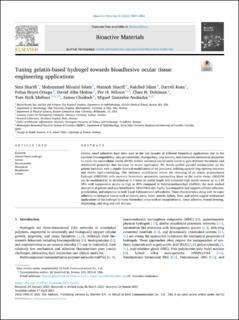| dc.contributor.author | Sharifi, Sina | |
| dc.contributor.author | Islam, Mohammad Mirazul | |
| dc.contributor.author | Sharifi, Hannah | |
| dc.contributor.author | Islam, Rakibul | |
| dc.contributor.author | Koza, Darrell | |
| dc.contributor.author | Reyes-Ortega, Felisa | |
| dc.contributor.author | Alba-Molina, David | |
| dc.contributor.author | Nilsson, Per | |
| dc.contributor.author | Dohlman, Claes H. | |
| dc.contributor.author | Mollnes, Tom Eirik | |
| dc.contributor.author | Chodosh, James | |
| dc.contributor.author | Gonzalez-Andrades, Miguel | |
| dc.date.accessioned | 2021-07-21T10:10:55Z | |
| dc.date.available | 2021-07-21T10:10:55Z | |
| dc.date.created | 2021-06-18T11:59:54Z | |
| dc.date.issued | 2021 | |
| dc.identifier.citation | Bioactive Materials. 2021, 6 (11), 3947-3961. | en_US |
| dc.identifier.issn | 2452-199X | |
| dc.identifier.uri | https://hdl.handle.net/11250/2764879 | |
| dc.description.abstract | Gelatin based adhesives have been used in the last decades in different biomedical applications due to the excellent biocompatibility, easy processability, transparency, non-toxicity, and reasonable mechanical properties to mimic the extracellular matrix (ECM). Gelatin adhesives can be easily tuned to gain different viscoelastic and mechanical properties that facilitate its ocular application. We herein grafted glycidyl methacrylate on the gelatin backbone with a simple chemical modification of the precursor, utilizing epoxide ring-opening reactions and visible light-crosslinking. This chemical modification allows the obtaining of an elastic protein-based hydrogel (GELGYM) with excellent biomimetic properties, approaching those of the native tissue. GELGYM can be modulated to be stretched up to 4 times its initial length and withstand high tensile stresses up to 1.95 MPa with compressive strains as high as 80% compared to Gelatin-methacryloyl (GeIMA), the most studied derivative of gelatin used as a bioadhesive. GELGYM is also highly biocompatible and supports cellular adhesion, proliferation, and migration in both 2 and 3-dimensional cell-cultures. These characteristics along with its super adhesion to biological tissues such as cornea, aorta, heart, muscle, kidney, liver, and spleen suggest widespread applications of this hydrogel in many biomedical areas such as transplantation, tissue adhesive, wound dressing, bioprinting, and drug and cell delivery. | en_US |
| dc.language.iso | eng | en_US |
| dc.publisher | Elsevier B.V. on behalf of KeAi Communications Co. Ltd. | en_US |
| dc.rights | Attribution-NonCommercial-NoDerivatives 4.0 Internasjonal | * |
| dc.rights.uri | http://creativecommons.org/licenses/by-nc-nd/4.0/deed.no | * |
| dc.title | Tuning gelatin-based hydrogel towards bioadhesive ocular tissue engineering applications | en_US |
| dc.type | Peer reviewed | en_US |
| dc.type | Journal article | en_US |
| dc.description.version | publishedVersion | en_US |
| dc.source.pagenumber | 3947-3961 | en_US |
| dc.source.volume | 6 | en_US |
| dc.source.journal | Bioactive Materials | en_US |
| dc.source.issue | 11 | en_US |
| dc.identifier.doi | 10.1016/j.bioactmat.2021.03.042 | |
| dc.identifier.cristin | 1916730 | |
| dc.description.localcode | © 2021 The Authors. Publishing services by Elsevier B.V. on behalf of KeAi Communications Co. Ltd. This is an open access article under the CCBY-NC-ND license (http://creativecommons.org/licenses/by-nc-nd/4.0) | en_US |
| cristin.ispublished | true | |
| cristin.fulltext | original | |
| cristin.qualitycode | 1 | |

